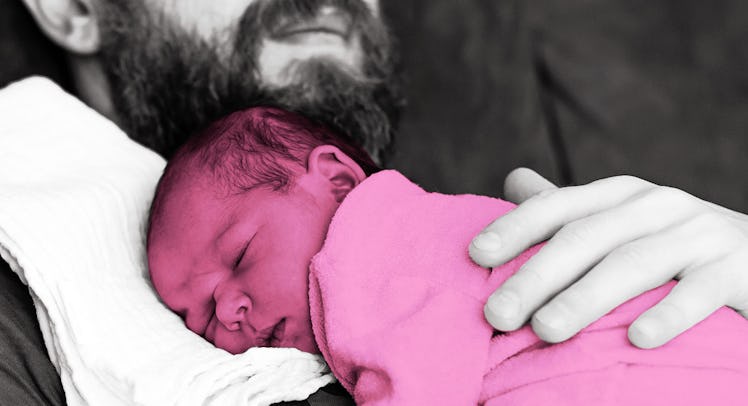How to Tell if Babies Are Happy Before They Can Smile
Babies communicate their feelings by crying and fussing. To know what’s going on in their heads requires extensive research in brain science.

Understanding the difference between a sad baby and a happy baby can be difficult. That’s why a lot of parents punt on the issue, bouncing their tots and asking, rhetorically, “Who’s a happy baby?” In truth, they have no idea so they’re deluding themselves. In reality, the are two ways to think about reading the moods of young children. There’s the wait until the baby can smile school and there’s the squinters, the folks determined to get a reading even though it’s hard as hell. If you’re part of that latter group, good for you. It’s nice that you’re being proactive — even though this whole thing is likely going to end in frustration.
Here’s how to tell if a baby is happy when the baby can’t communicate happiness. And, no, the answers aren’t satisfying so don’t say we didn’t warn you.
The Easy Way to Tell If a Newborn is a Happy Baby
Is the baby crying? No? Then they’re probably good.
“When a child is only weeks old, the way they express themselves is really very simple — it’s a level of distress or contentment,” says Nicci Schmidt, Research Program Manager of The Baby Brain and Behavior Project at the Center for Healthy Minds at the University of Wisconsin-Madison. When a child is crying and they’re hours, days, or weeks old, Schmidt says, they’re communicating their needs, at a base level — they’re hungry, in pain, or uncomfortable.
The Not-So-Easy Way to Tell If a Newborn is a Happy Baby
More nuanced insight into what is going on inside a newborn’s soft little head requires more than paternal intuition. Quite a bit more, in fact. Teams of researchers with imaging equipment and theories scaffolded on decades of peer-reviewed research are still looking into it.
“Any parent is well aware of when an infant dislikes something,” Schmidt says, “and when we observe a child at a few weeks of age we’re really limited to observations around levels of distress, and it is very simple: They are not distressed, they are a little distressed, or they are very distressed.”
RELATED: Why Don’t Newborn Babies Smile? Why Do They Look So Worried?
Part of the problem lies with the fact that, evolutionarily speaking, it doesn’t matter if parents know how their child is feeling at that age. Crying and fussing alone is very effective at keeping babies alive. Infants are really, really good at communicating distress, which prompts their caregiver to meet their needs to make the crying stop.
While a newborn isn’t capable of communicating much beyond an error message, even very young babies are still very much aware of their surroundings, Schmidt says. “They aren’t interacting with you in the way a 5-year-old does,” Schmidt says, “but they’re very much a full human creature, and they are certainly aware that you are there.”
This awareness of their surroundings means that experiences may have an effect on development. What effect those experiences may have is totally unclear — researchers will get back to you — but Schmidt says that it’s important to understand that babies are attuned to the emotions of their parents. “When infants are very young they’re really learning through parent filters,” Schmidt says, adding that the way in which the child is tuned in emotionally and biologically with their surroundings can affect them. “If a parent is really distressed, then the child is experiencing those cues,” Schmidt says.
Schmidt says that her research uses a combination of well-established assessment tools and modern imaging techniques to glean a better understanding of how babies’ brains develop and mature during this time. Preliminary findings suggest that during those first few months, infant development is widely varied, and baby brain development is fast.
MORE: Why Babies Stop Crying When Parents Stand Up
This research comes in part from standardized research tools — such as the Infant Reactivity Inventory, which is a series of 15 questions about level of distress in different scenarios, such as bathing, diaper changes, and being tickled, and so on — and in part from neuroimaging assessments with infants at one month of age, where researchers perform a scan during a baby’s natural nap time.
“When they’re happy with a full belly, a clean diaper, and asleep, we get a brain scan on them,” Schmidt says. These scans show a much greater variability than observational data, where the metrics are limited. “It’s very simple in an observed environment, but at the brain structure-function, we see a lot of variability going on. The exciting thing we’re doing is following these infants to hopefully identify more relationships between these important markers of variability and the kinds of experiences that they have.”
This quiet time devoid of smiles and explicit communication is short-lived, and it doesn’t take long before parents will notice their baby’s first interactions with the outside world. After about 12 weeks, Schmidt says, there is a whole host of developmental benchmarks that are easier to observe. “At three months, it’s an orchestra of different skills, such as the vision and motor skills, speech, and social interaction,” Schmidt says. “Layered upon that is emotion and regulatory capacities.”
This article was originally published on